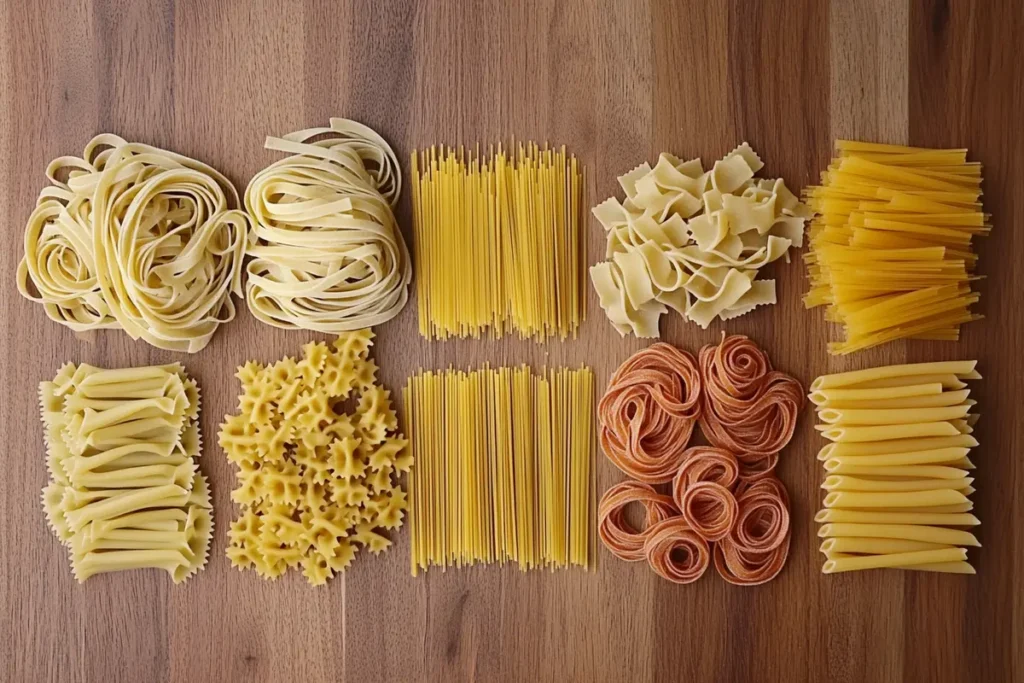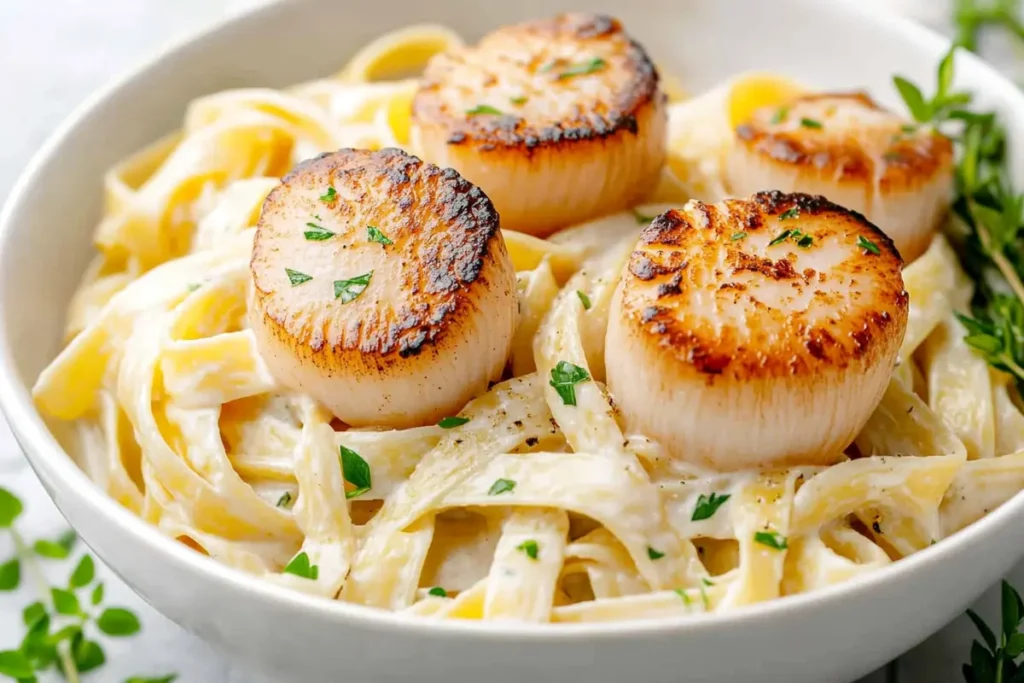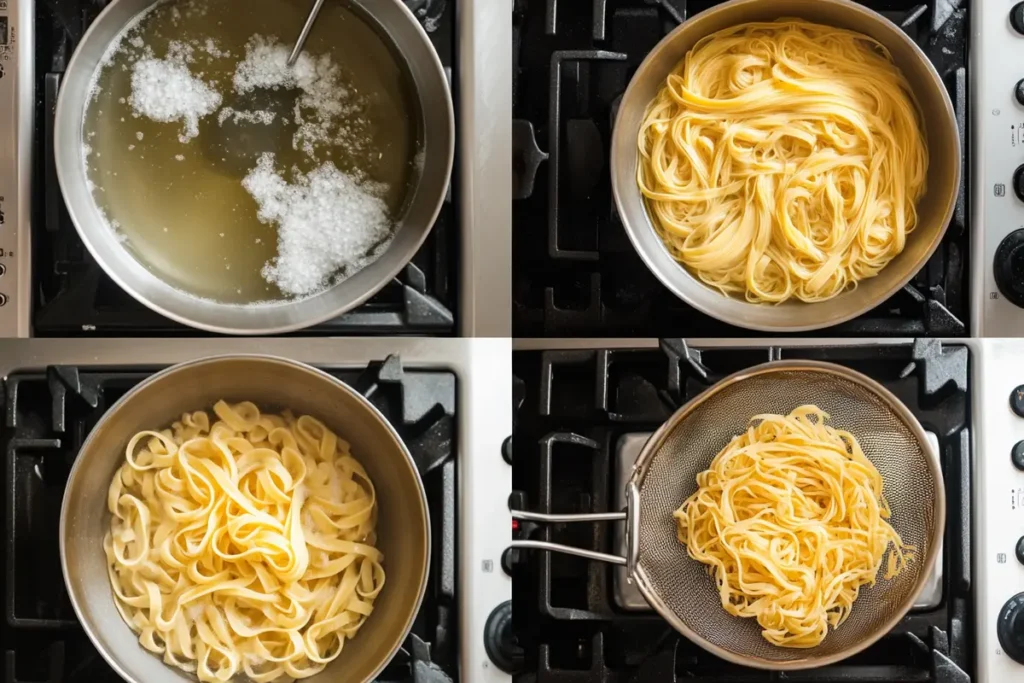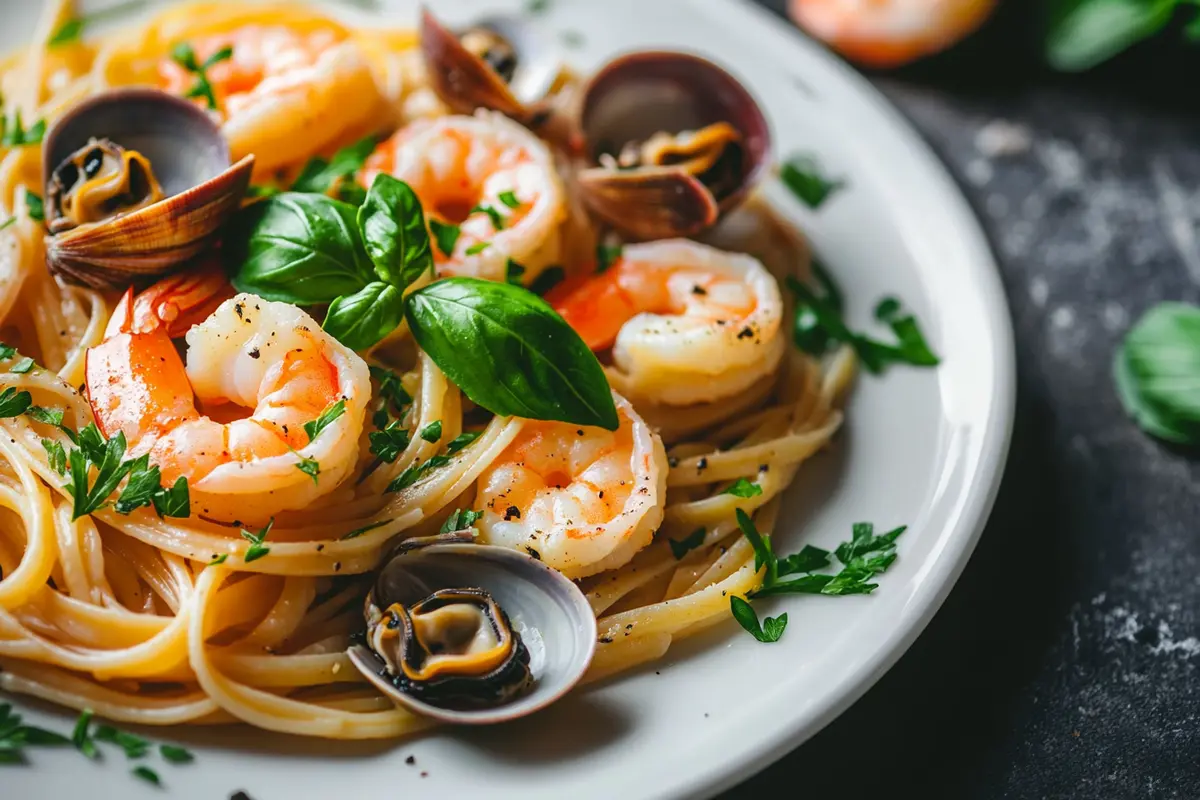Choosing the right pasta is essential for a great seafood pasta dish. The pasta shape needs to complement the sauce and the seafood. Therefore, knowing which pasta works best is important for any home cook. This article will explore several types of pasta that work well in different seafood pasta recipes. Moreover, we’ll offer tips to help you create the perfect dish every time.
The ideal pasta for seafood pasta should be able to hold the sauce and seafood. Long, thin shapes are popular. However, other options can be great too. You need to consider the sauce and the type of seafood you’re using. This ensures a balanced flavor and a great eating experience. For example, you can look at some regional Italian preferences for more insight. You can explore more about the history and different types of pasta here: Pasta Shapes Guide. This can offer more context to the topic.
Moreover, the type of pasta can affect the overall texture of your dish. Some pastas are great for creamy sauces, while others are better for light, oil-based ones. Therefore, choosing the right pasta type is very important. It’s not only about looks. It’s about creating a nice balance of flavors and textures. The right pasta will turn a basic seafood pasta into an amazing meal. You can also look at the regional differences in sauces and pasta choices, on a site like: Regional Italian Pasta. This may also help to make informed choices.
Table of contents
- Common Pasta Choices for Seafood Pasta
- Understanding How Pasta Shapes Work
- What Type of Pasta is Best for Seafood Pasta Based on the Sauce
- What Type of Pasta is Best for Seafood Pasta Based on Seafood
- Step-by-Step for Cooking Pasta for Seafood Pasta
- Tips for the Best Seafood Pasta
- Variations of Seafood Pasta
- Serving Ideas for Seafood Pasta
- The Health Benefits of Seafood Pasta
- Frequently Asked Questions
Common Pasta Choices for Seafood Pasta
Several pasta types are used for seafood pasta. Here are some of the most popular ones:
- Linguine: This is a classic choice for seafood pasta. Its long, flat shape holds oil-based sauces well. Linguine works great with most types of seafood.
- Spaghetti: This long, thin pasta is very popular. It works well with many sauces. However, make sure the sauce is not too thick. It’s great with small pieces of seafood.
- Fettuccine: This flat, wide pasta is best for creamy sauces. Its width lets it hold rich sauces well. It is not ideal for lighter sauces.
- Bucatini: This thick, spaghetti-like pasta has a hole in the middle. Therefore, the sauce goes inside. It’s great for seafood pasta with more liquid.
- Pappardelle: These broad, flat noodles are great for heartier dishes. They work well with large pieces of seafood in a rich sauce.
- Tagliatelle: This flat, ribbon-like pasta is similar to fettuccine. It holds creamy sauces well and works with seafood like crab and lobster in a delicate sauce.
- Penne: This tubular pasta is best with chunky sauces. It’s a good choice if you have bigger pieces of seafood or vegetables in your dish. The sauce will fill the ridges of the pasta.
These pasta shapes are often used, but there are many others to choose from. The main thing is to match the pasta to your sauce. Also, consider how the shape pairs with your seafood.

Understanding How Pasta Shapes Work
Choosing the right pasta is about how well it works with the sauce and the seafood:
- Long, thin pastas, like linguine and spaghetti, are best with light, oil-based sauces. The sauces coat the pasta well without overpowering the seafood flavor.
- Wide, flat pastas, such as fettuccine and tagliatelle, are good for creamy sauces. The wide area lets them hold the sauce well. This gives a luxurious feeling.
- Tubular pastas, such as penne and rigatoni, work well with thick, chunky sauces. The sauce fills the pasta ridges, making each bite flavorful. These shapes hold seafood pieces well.
- Unique shapes, such as bucatini and pappardelle, provide a unique eating experience. They offer variety. Bucatini is good for thinner sauces. Pappardelle works best with heavy sauces.
Knowing these things can help you pick the best pasta. Each pasta type has a special texture that impacts the dish’s flavor. Trying different combinations can be a fun experience.
What Type of Pasta is Best for Seafood Pasta Based on the Sauce
The sauce is as important as the seafood for picking the right pasta. Here’s a look at pairing sauces with pasta:
- Oil-based sauces: Choose linguine, spaghetti, or capellini for a simple garlic and oil sauce. Thin strands absorb the sauce. They won’t overpower the dish. These are good with delicate seafood.
- Creamy sauces: Use fettuccine, tagliatelle, or pappardelle for a creamy sauce. These noodles can hold the rich sauce and the seafood flavors.
- Tomato-based sauces: Spaghetti, penne, and rigatoni work well with tomato-based sauces. The shapes allow the sauce to stick to them. Penne is great with a chunky tomato sauce.
- Broth-based sauces: Linguine, spaghetti, and bucatini are good for a light broth-based sauce. These shapes capture the broth and seafood well. Thin strands work well in this type of recipe.
- Pesto sauces: Pesto sauces work well with trofie, linguine, or fusilli. These pasta types hold onto the pesto nicely.
The sauce’s consistency and flavor help you pick the best pasta. The right match enhances the meal. A great sauce should add to, not hide the flavor of, the pasta.
What Type of Pasta is Best for Seafood Pasta Based on Seafood
The type of seafood is important for choosing the right pasta too:
- Shrimp: Linguine, spaghetti, and penne are great choices for shrimp pasta. Their shapes work well with shrimp and sauce.
- Clams: Linguine and spaghetti are classic for clam sauces. Their thin shape allows the clam flavor to stand out. The pasta should not be too thick.
- Mussels: Linguine, spaghetti, and bucatini are good for mussels. These shapes work well with the broth sauces that often come with mussels. Bucatini is good because the broth fills the center.
- Scallops: Fettuccine, tagliatelle, and pappardelle are good for scallops. These pastas hold creamy sauces well. They work especially well with a creamy lemon sauce.
- Lobster: Fettuccine and tagliatelle work well with lobster pasta. Wide noodles go well with the rich sauces often used for lobster.
- Crab: Linguine, tagliatelle, and spaghetti are great with crab. Delicate crab meat pairs well with these pasta types. The sauce coats the pasta well, giving it even flavor.
The size and texture of your seafood should influence your pasta choice. Larger pieces might be better with wider pasta shapes. Smaller pieces work well with thin ones. This consideration can greatly enhance the dish.

Step-by-Step for Cooking Pasta for Seafood Pasta
Here are some steps for cooking pasta perfectly for your seafood pasta dish:
- Use a big pot: Make sure the pasta has room to move. This keeps it from sticking.
- Use lots of water: Fill the pot with enough water. Use at least 6 quarts of water for each pound of pasta.
- Salt the water well: Add salt to the water when it boils. This seasons the pasta.
- Add the pasta: Add the pasta to the boiling water. Stir gently to prevent it from sticking.
- Cook al dente: Cook the pasta until it is al dente. It should be firm, not mushy. Check the package directions for timing.
- Save pasta water: Before draining, save some pasta water. This starchy water can help the sauce to stick to the pasta.
- Drain the pasta: Drain the pasta. Do not rinse it with water.
- Add pasta to sauce: Add the pasta to the sauce in a pan. Mix immediately, so the sauce can coat the pasta.
Following these steps will ensure that your pasta is perfect every time. They are simple, but have a large impact. Well-cooked pasta is key to a great dish.

Tips for the Best Seafood Pasta
Here are some tips to help you make great seafood pasta:
- Use fresh seafood: Fresh seafood has the best flavor and texture. Freshness makes a big difference.
- Do not overcook the seafood: Seafood cooks quickly. Overcooked seafood can be tough. Add it to the sauce towards the end.
- Use good olive oil: Good olive oil enhances the dish. It is a must for great Italian cooking.
- Season well: Season the pasta water and the sauce well. This brings out all of the flavors. Season as you cook to get the best results.
- Use fresh herbs: Fresh herbs can make your seafood pasta taste even better. Fresh herbs add a boost of flavor.
- Add some acidity: A little lemon juice or white wine can brighten the flavors. Acidity makes the dish even more flavorful.
- Serve it right away: Seafood pasta is best served hot. It’s best to assemble it just before serving to ensure the pasta is well coated.
These tips can help you make the perfect seafood pasta. Small details can change the final product. So, pay attention while cooking.
Variations of Seafood Pasta
Seafood pasta is very versatile. Here are some variations you can try:
- Spicy Shrimp Scampi: Add red pepper flakes for a spicy kick. The heat gives an extra flavor boost.
- Creamy Lobster Pasta: Combine lobster meat with a creamy sauce for a luxurious dish. This is a great option for special occasions.
- Clams and Garlic White Wine Pasta: This simple Italian dish is very flavorful. The garlic, wine, and clam flavors are a great combination.
- Seafood Fra Diavolo: This spicy tomato sauce with seafood is great if you like heat. It’s a bold and flavorful dish.
- Lemon Garlic Shrimp Pasta: This is a simple dish with lemon, garlic, and shrimp. It is a light, refreshing, and quick option for a weeknight meal.
- Mussels in White Wine Sauce: Serve mussels in a white wine sauce with linguine or bucatini. It is an elegant, classic dish.
- Pesto Seafood Pasta: Add pesto to your choice of seafood and pasta. It’s a quick and very easy meal.
Try these variations to create your unique seafood pasta dish. There are many options to explore. You can add or remove ingredients to suit your taste.
Serving Ideas for Seafood Pasta
Seafood pasta can be paired with different sides for a complete meal. Think about these options:
- Garlic bread: Crusty garlic bread is great for soaking up the sauce. It’s a classic pairing for any pasta dish.
- Side salad: A fresh salad with a light dressing will balance the richness of the seafood pasta. This is a simple and light option.
- Roasted vegetables: Roasted vegetables such as asparagus, zucchini, or bell peppers work well with the pasta. They provide nutrients and flavor.
- Grilled vegetables: Grilled vegetables add a smoky flavor that is great with seafood pasta. This also provides a textural contrast.
- Lemon wedges: Serve with lemon wedges to add more acidity to the dish. They provide a fresh burst of flavor.
- White wine: A crisp white wine goes well with seafood pasta. It enhances the meal.
These options help you make a balanced meal. They also elevate the dish. A mix of textures and flavors makes the meal complete.
The Health Benefits of Seafood Pasta
Seafood pasta has several health benefits, depending on the ingredients:
- Seafood is rich in protein: Protein is important for building and repairing tissues. It keeps you full for a longer time.
- Seafood is rich in omega-3s: Omega-3s are good for your heart. They can also lower cholesterol.
- Vegetables are full of nutrients: Add vegetables, such as tomatoes, garlic, and spinach, for vitamins and minerals.
- Whole grain pasta: Choosing whole grain pasta adds fiber and improves digestion. It also promotes a healthier gut.
- Olive oil: Olive oil is a healthy fat that is good for your heart. It also adds great flavor to the dish.
Seafood pasta can be a healthy meal if you use good ingredients and control the portion size. It’s a tasty and nutritious option for a balanced diet.
Frequently Asked Questions
Here are some common questions about seafood pasta:
What type of pasta is best for seafood?
Linguine is often considered the best for seafood. However, spaghetti, bucatini, and tagliatelle are also great options. The best option depends on the sauce and type of seafood. Therefore, the key is to choose a pasta that pairs well with the ingredients.
What type of pasta is best for creamy pasta?
Fettuccine and tagliatelle are best for creamy sauces. Their wide shape helps them to hold the sauce. This makes a luxurious, flavorful dish.
What to pair with seafood pasta?
Seafood pasta goes well with garlic bread, salads, roasted vegetables, lemon wedges, and white wine. These pairings complete the meal well. The sides also balance the flavors and textures.
Why is linguine served with seafood?
Linguine is often served with seafood because it has a long, flat shape that holds oil-based sauces well. It also goes well with most seafood, making it a popular choice. It is a classic pairing for many reasons

